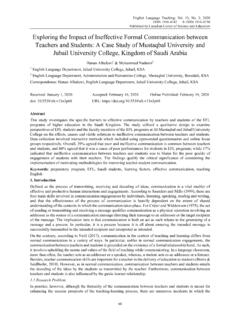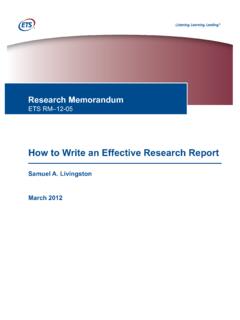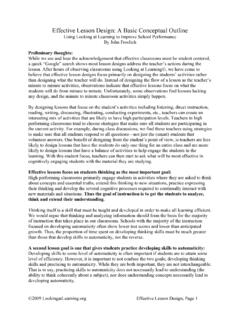Transcription of Overall Labor Effectiveness (OLE)
1 Overall Labor Effectiveness (OLE): Achieving a Highly Effective Workforce Achieving a Highly Effective Workforce A sound measurement framework is something every manufacturer would like to have. Yet today, most measurement systems focus on machinery Effectiveness or production output. Manufacturers measure time and attendance carefully, but beyond that, few have a method of understanding the effective use of their workforce. This white paper will provide a description of Overall Labor Effectiveness (OLE) and discuss how to use it as a tool to improve the Overall Effectiveness of the Labor force.
2 Why Labor Is the Next Frontier in Overall Manufacturing Performance Manufacturers know the problem well. Entering the quarter with a sizable backlog, the management team is optimistic about steady revenues and high profits. Yet when the results are tallied, the profitability expected doesn't materialize. Postmortems show no important equipment failures, no Labor issues that drained productivity, and profit nowhere near the level everyone thought possible. The culprit? Beyond operating failures, very likely the problem can be traced to a host of workforce-re- lated issues that accumulated as the plant ran at less-than-optimum capability.
3 Some probable causes: The plant's hard assets weren't used efficiently due to difficulty scheduling the right resources when and where their specific skills were required. Absenteeism of critical individuals contributed to the problem. Undelivered or ineffective training hampered quality output and slowed production ramp ups the same for changeovers and new product startups. Factors like these are drawing attention to Labor as the next critical manufacturing element to optimize in today's demand-driven world. During the past decade, manufacturers poured attention and resources into supply chain improvements as a way to increase competitiveness and profitability.
4 It was a successful strat- egy, but now it's hitting the law of diminishing returns. Savvy managers have realized that their workforce can be the engine that drives supply chains and manufacturing in the quest to move to the next level of performance. And the pressure is getting greater. For many manufacturing executives, dealing with a changing workforce, competing with offshore manufacturing, and maintaining profitability are factors of corporate survival and these goals will be achieved only if they can optimize their workforce performance.
5 Defining Overall Labor Effectiveness (OLE). Optimizing workforce performance requires new insight. Attaining that insight requires companies to establish methods of quantifying, diagnosing, and ultimately predicting the performance of their workforce one of the most important and highly variable elements of manufacturing. That insight can be provided by Overall Labor Effectiveness (OLE). Simply put, OLE is the analysis of the cumulative effect three workforce factors have on productive output: ilability: the percentage of time the workforce spends making effective contributions Performance: the amount of product delivered Quality: the percentage of perfect or saleable product produced Achieving a Highly Effective Workforce Quality OLE.
6 Availability Performance OLE is the key to understanding the effect the workforce has on manufacturing performance and, most important, it provides a platform that helps diagnose and predict that performance. OLE: A partner to OEE. OLE has a precursor in a metric known as Overall Equipment Effectiveness (OEE). Designed to ensure maximum output from machines, OEE has been a bellwether of performance for manufacturing managers in asset-intensive industries, such as chemicals and refining. To understand OLE completely we must understand OEE, the relationship between the two, and how they work together to raise Overall manufacturing productivity and performance.
7 OEE is a formula that shows the Overall performance of a single piece of equipment, or even an entire factory, and is governed by the cumulative effect of three factors: the equipment's availability (percentage of scheduled production time available), performance rate (percentage of parts produced compared to standard), and quality (percentage of saleable parts produced compared to parts started). OEE takes a holistic view, and many managers feel it is the best tool for managing operations in the context of cost- and efficiency-focused manufacturing.
8 OEE is an effective measure, but it doesn't tell the whole story. In today's demand-driven operations, many manufacturing environments no longer place a high value on flat-out volume production. Shorter cycles and more frequent changeovers . which reduce the OEE values are more important, lessening the value of OEE as an indicator of manu- facturing productivity. The shortcomings of OEE as a stand-alone measure are related to the interactions of Labor with equipment: In asset-intensive industries, such as refining, the ratio of employees to assets is very low.
9 If a certified operator isn't available to start a machine, OEE looks negative but impaired output was not caused by the machine's potential. OEE doesn't capture the interdependency of the direct and indirect workforce. For example, machine availability may be high, driving good OEE. A deeper look, though, may show that the maintenance staff is spending significant amounts of time to keep the machine running. As a result, other areas suffer indirectly, since maintenance resources are not available to them, which causes Overall workforce productivity to drop.
10 Similarly, attendance, scheduling, breaks, and other workforces issues are not directly captured. OEE doesn't work when there isn't a machine to measure. Many critical manufacturing processes don't have a machine to capture measurements from. For example, a welding station depends upon highly skilled (and difficult to recruit) workers performing a manual process. Achieving a Highly Effective Workforce OEE does not have a comparable cost metric and for good reason, as machines generally have predictable costs, such as depreciation and scheduled maintenance.







